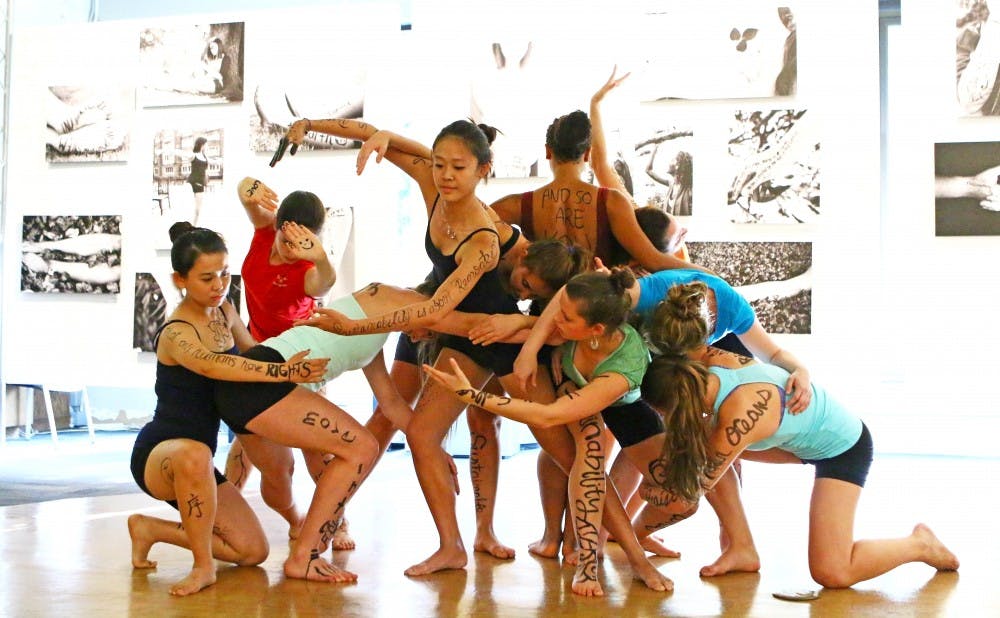Sporting a hot pink jacket, Ruth Day, director of the Medical Cognition Lab and associate professor of psychology and neuroscience, turned her monitor to show a modern dance video of six men in tuxedos bobbing their heads while stomping their feet.
“Now how many dancers were there on stage,” Day asked after moving her screen out of sight.
This is one of the many tests Day runs in her lab to find new connections between the way people perceive and remember movement. As part of the Memory for Movement Lab—a facet of the Cognition Lab that involves novice and experienced dancers and athletes, professional dance companies and audience members-—Day attempts to understand how audience members and dancers perceive and remember performances.
Through these experiments, Day said she hopes to find methods by which dancers and audience members can enhance their memory perception and retrieval in order to mitigate errors on stage and create a more enriching viewing experience.
During our meeting, Day used one of her methods that test how people perceive movement—showing a dance clip and asking follow-up questions.
“You can’t ask what did you see because they can’t tell you,” Day said. “You have to ask what stands out—and surprisingly people always say very little about the movement. It is the core part of the piece and they’re just not getting it.”
Day uses a central concept she calls “segmenting the dance stream” in order to analyze various ways that people handle this type of information overload.
“Chunking,” for example, is the way in which people break down movement sequences according to certain patterns such as level of movement, change in direction and repetition.
Research subjects watch dance clips and are asked, over the course of several trials, to hit the spacebar whenever they want to consciously “chunk” the sequence. Day then evaluates these chunking patterns across a timeline of the piece, assessing critical moments where a majority of participants chunked the sequence of movement.
Participants are then asked to engage in free recall, an attempt to recreate the movements they watched on the screen. Day said that those who chunked the pieces more consistently across the trials showed a greater percentage of free recall than those who chunked inconsistently.
Through this research, Day is able to evaluate the relationship between the visual features people chunk and what they remember.
“We are able to determine what captures their attention and the details that drive it,” she said.
Problems associated with memory often involve errors in encoding, the process by which the brain translates information into a form that it can use and store. Improper encoding techniques can result in issues with memory retrieval—the memory still exists, but the brain does not know how to get it back.
“When people are getting complex information, how do they handle it?” Day asked. “What can we do to enhance the amount of information they absorb and retain?”
But there are also other methods that Day said can enhance one’s memory. Memory cues, such as names, counts and sounds associated with a specific pattern of movement are extremely important in the process of memory retrieval.
“If you attach something, such as a name, to a visual display, you can use it as a cue to get it back later, ” Day said.
Using this principle, Day created a movement library, a collection of movements that researchers generate and show to research subjects. Participants are then evaluated based on the ease with which they can assign a name of their choice to the movements.
Day is able to compare the recall of the easily nameable movements and those that were more difficult to name. The movements which participants are better able to recall, Day said, are those which they can associate with another common object or type of movement.
For six weeks over the summer, Day transfers her lab to the American Dance Festival studios, which provide an educational and professional foundation for dance training in Durham.
Director of ADF Jodee Nimerichter said that one of the hardest things for the dance field is finding ways for the audience to explore the true essence of modern dance.
“[Day’s] work helps break down barriers for people who watch dance performances,” Jodee said. “In enabling dancers and audiences to view movement in a different way, her workshops illuminate and heighten the visceral experience that dance is.”
Senior Elizabeth Potash, a psychology major and dance minor, worked at ADF over the summer and showed research participants the dance clips as part of the cognitive research. She found that the experience level of dancers did not always correlate directly with the way they remembered the sequences.
Potash said her ultimate takeaway from the experience was that dancers learn movements in a variety of ways, and that instructors use different audio and visual cues to accommodate this type of learning.
Day is currently expanding her research to other sports including martial arts, karate and football.
“We want to know how the mind works, not just in carefully controlled lab experiments, but in a world where people are motivated to do things that are important—where doctors care about prescribing the right drugs and dancers care about getting the movement right,” Day said.
Get The Chronicle straight to your inbox
Signup for our weekly newsletter. Cancel at any time.

